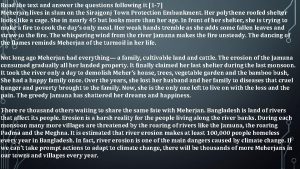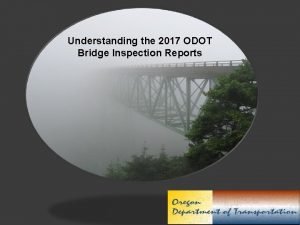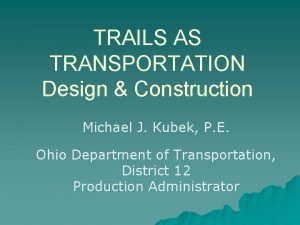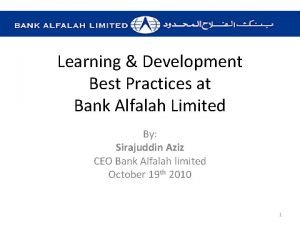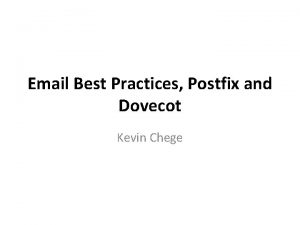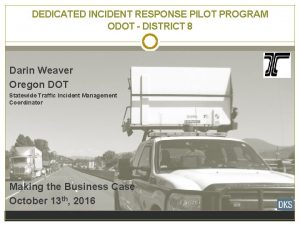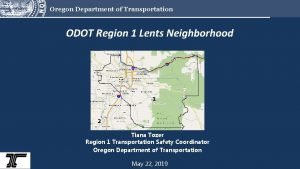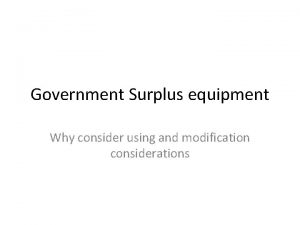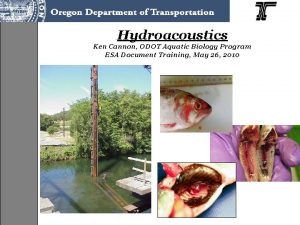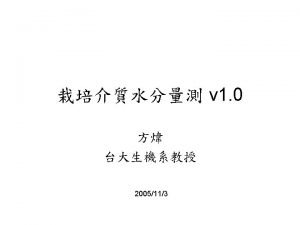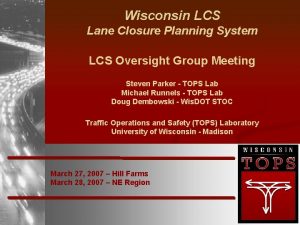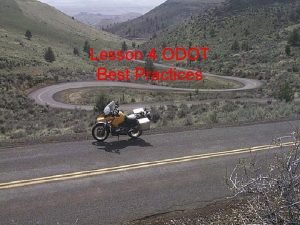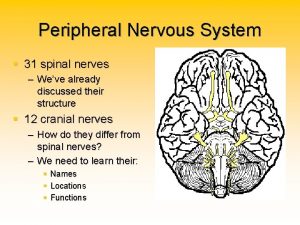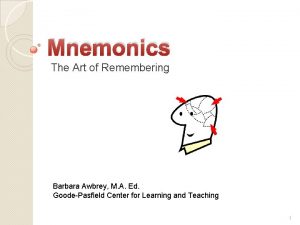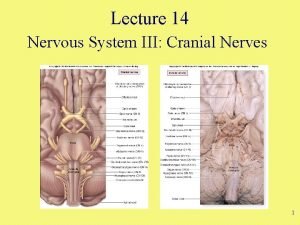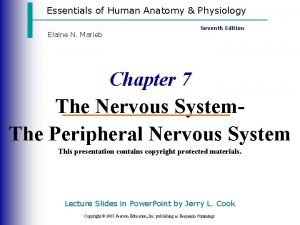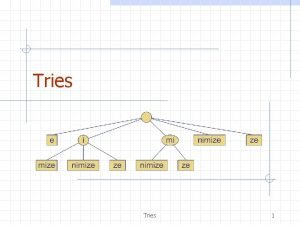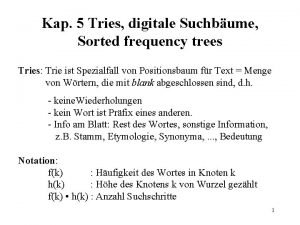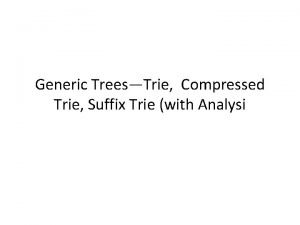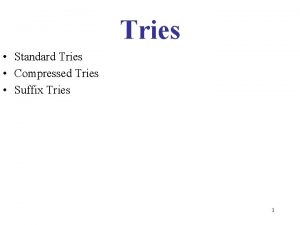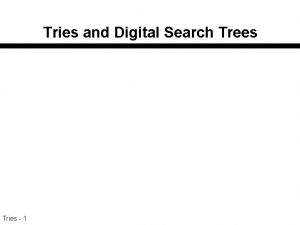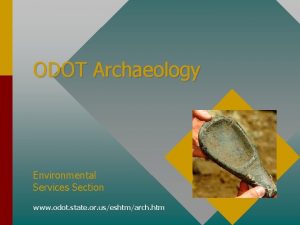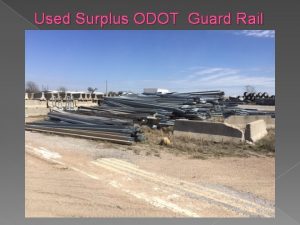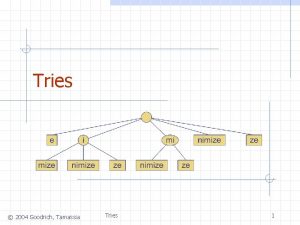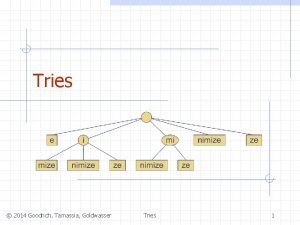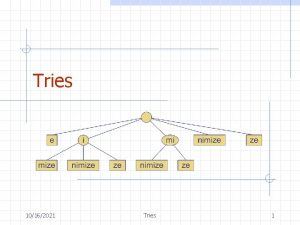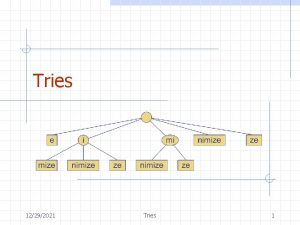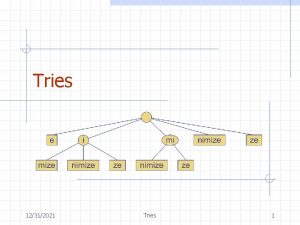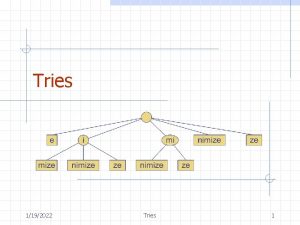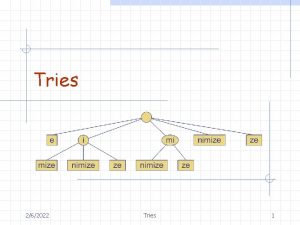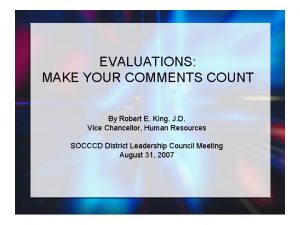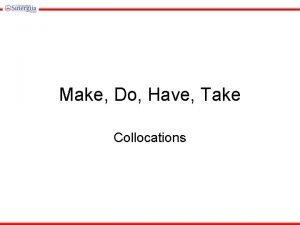How ODOT Research Section Tries to Make Your






















- Slides: 22

How ODOT Research Section Tries to Make Your Life Easier Matthew Mabey, Ph. D. , P. E.

The Life Cycle of a Research Project: Project Solicitation to Publication • Solicitation and Submission of Problem Statement • Evaluation of Problem Statement by ETG and RAC • Identification of Problem Statement for Funding • Develop Work Plan and Contract for Research • Review of Literature, Design of Experiment, Collection of Data and Analysis of Data • Results Reported and Reviewed • Publication of Results

ODOT State Planning and Research-Part II Project Selection September: Expert Task Groups update strategic priorities October: Solicitation of Problem Statements July: With the start of new Fiscal Year, funds become available for the selected projects November: Deadline for Problem Statement submission March-June: Selected projects are developed December: Expert Task Groups select problems statements to be advanced to the Research Advisory Committee February: December. Research Advisory Committee February: meets to prioritize and Stage Two Problem select problem statements Statements developed

Geo-Hydro-Enviro Research Projects Selected in the 21 st Century • • • • • FY 2000 Fish passage, published November 2004 FY 2000 Roadway Applications of Vegetation and Rip-Rap for Stream-bank Protection, published January 2002 FY 2001 Monitoring Water Quality Facilities , published January 2007 FY 2003 Monitor Bioengineering , published August 2009 FY 2003 Coastal Landslides , published July 2008 FY 2004 Drainage Facility Management System , published June 2009 FY 2004 Chitosan , published October 2005 FY 2004 Dynamic Revetments , published Aug. 2005 FY 2005 Deer Movement , on-going FY 2005 Low-Flow Stream Flow , published Aug. 2008 FY 2006 Metallic MSE Wall Reinforcement , published May 2008 FY 2007 Rainfall Analysis , published Jan. 2008 FY 2007 Waterway Enhancement Construction Methods , on-going FY 2008 Copper in Stormwater and ESA Salmon , on-going FY 2009 Asphalt Millings and Lead-painted Concrete , literature review only FY 2009 Naturally Occurring Hazardous Materials , on-going FY 2010 Fluvial Performance Standard , in development FY 2010 Climate Change and Coastal River Estuaries , in development FY 2010 Pipe Ramming , in development

Fish Passage through Culverts • Stage One Objective: “We propose the funding of a 5 -year systematic program of monitoring the physical performance, particularly hydraulic performance and bed stability, of new culvert installations designed to pass fish, and existing installations that are retrofitted to provide fish passage. ” • Outcome: The project clearly demonstrated that culverts retrofitted with ODOT baffles were traversable by juvenile salmonids where the culvert without the baffles was not. These baffles had already been widely used. Are they still being installed?

Monitor Water Quality Facilities • Stage One Objective: This project would compare various types of water quality facilities for pollutant removal capabilities and cost effectiveness. • Out Come: This project evolved into the development of a water quality monitoring template to be tested on ODOT facilities. The template is available and usable. Are any of you using it?

Monitor Bioengineering • Stage One Objective: As design guidance is lacking in the bioengineering field, any information is very useful to designers faced with challenges in this ever-growing arena. Monitoring existing bioengineered sites to develop information useful for design is a tangible approach to the problem. • Out Come: This project did monitor the flow conditions at four bioengineered sites. All of the sites were very stable during monitoring. Unfortunately, this project was also a victim of the reorganization. The baseline data for quantitatively documenting changes to the banks and channels was lost in all the shuffling. Is there an inventory of ODOT bioengineering installations?

Drainage Facility Management System • Stage One Objective: This project would develop a data management system to address ODOT’s need to track, document, and supply information concerning storm water facilities. • Out Come: The research project provided guidance that was used for the DFMS that is (nearly? ) ready to be deployed. The research activities seemed to serve as a stimulus to ISB embracing the project. The DFMS will be the new official culvert database for ODOT.

Chitosan • Stage One Objective: ODOT proposes to study the use of Chitosan for in-situ turbidity reduction to meet water quality standards for construction-impacted water that escapes the diversion during Temporary Water Management. • Out Come: The study concluded that Chitosan does have the potential to reduce in-stream turbidity and doesn’t present a hazard to the aquatic ecology. It is however sensitive to water conditions, such as p. H, and thus its use would have to be carefully planned and monitored. The next step after the research project was to try using chitosan on an actual in-water project. Has that step been taken?

Dynamic Revetments • Stage One Objective: Important for minimizing such negative impacts (from hard engineering) is the testing of “soft” engineering alternatives that attempt to replicate nature by slowing the erosion to an acceptable rate while eliminating or reducing scour and beach sediment losses. • Out Come: This project documented the properties and stability of naturally occurring cobble beaches and the availability of materials to construct artificial copies of these beaches. This information has been published in the final report. Has anybody at ODOT built a dynamic revetment yet? If not, why not?

Coastal Landslides • Stage One Objective: The Johnson Creek Landslide and others of similar nature (large translational slides in seaward dipping Tertiary sedimentary rock) pose an ongoing threat to public safety and are a continual, very expensive highway maintenance issue. • Out Come: The research project clearly showed the dual mechanisms driving movement of these slides. Erosion of material at the beach bluff prevents them from equilibrating while heavy precipitation triggers movement by quickly raising pore water pressures. Depending on the specific site conditions, either buttressing/armoring or intercepting precipitation water would stabilize these slides. Has this been proposed anywhere yet?

Low-Flow Stream Flow • Stage One Objective: Fish Passage, Temporary Water Management and Stormwater Quality designs all require the use of low flows (flows less than a 2 -yr storm) for designs. • Out Come: At ODOT’s behest, and with SPR funding, the USGS has complied low-flow regression equations for all streams in Oregon. Are you using these equations?

Rainfall Analysis • Stage One Objective: Stormwater management to meet environmental regulations requires rainfall data with greater detail than is currently available for the state of Oregon. Current precipitation intensity information for Oregon utilizes precipitation information obtained from National Weather Service studies conducted in the 1960’s. • Out Come: The Oregon Climate Service complete isopluvial maps for the state of Oregon using modern data and methods that match similar maps for Washington and California. This was a cooperative effort with OWRD and COIC. Are you using these maps?

Metallic MSE Wall Reinforcement • Stage One Objective: Are the metallic MSE wall reinforcements degrading at an acceptable rate in terms of the 75 -year service life? What changes are recommended to the wall design process to ensure acceptable longevity to these assets? • Out Come: This project had difficulties due to the Principle Investigator having serious health problems. None-theless, research published by others, after the project was begun, clearly show that the standard guidelines are very conservative. If the guidelines have been followed, then ODOT need not be concerned. One key change in past practice that should be occurring is the inclusion of recoverable, sacrificial reinforcement material in all future ODOT MSE walls.

Waterway Enhancement Construction Methods • Stage One Objective: Waterway enhancements may be a more cost effective solution at locations were existing culverts and bridges are structurally sound yet do not meet current fish passage rules and regulations. Evaluate current construction methods and determine better construction and compaction methods for roughened chutes or channels. • Status: This project should be completed this year. It is hopefully being presented at the Annual TRB Meeting in Washington, D. C. It appears they have some promising findings and recommendations.

Copper and Salmon • Stage One Objective: Recent laboratory research by the National Marine Fisheries Service (NMFS) concluded that as little as 1 to 5 ppb (parts per billion) of dissolved copper can impair the olfactory and lateral line 1 systems of threatened and endangered (T&E) salmon (Oncorhynchus spp. ). What are the amounts and ratios of bio-available and non bioavailable copper in highway stormwater runoff? • Status: This project should be completed sometime early next year. Preliminary results seem to indicate that the majority of copper in highway runoff is not bioavailable, but we will need to wait for the project to be completed.

Naturally Occurring Hazardous Materials • Stage One Objective: Naturally occurring hazardous minerals are found throughout the state and can be easily overlooked while doing environmental assessments and geologic investigations for specific projects. Developing a list of naturally occurring hazardous minerals that may be hazardous when disturbed by construction activities will help address this issue. Mapping the locations of known such mineral deposits along state highway right-of-way including material sources, staging areas, disposal and stockpile sites will help make this information readily usable • Status This project began this spring and is progressing nicely.

Pipe Ramming • Stage One Objective: Currently there are no proven methods of estimating driving stresses during pipe ramming. This results in increased costs because of the uncertainty in design. • Status: This project is in development. We had our first Technical Advisory Committee meeting last week.

Fluvial Performance Standards • Stage One Objective: The "fluvial performance standard", developed for the OTIA III Bridge Programmatic Biological Opinion and incorporated into SLOPES IV, sets a minimum opening width for bridges and culverts that is intended to protect channel processes and in-stream habitat. A concern with the imposition of this standard on all ODOT projects is the additional cost arising from having to build longer bridges and place abutment protection away from the actual channel. While these costs are being tracked, no analysis has been done of the potential benefits of longer bridges/wider culverts. • Status: We have recently identified someone that might be interested in being the Principle Investigator for this project.

Climate Change and Coastal Estuaries • Stage One Objective: U. S. Route 101 and other ODOT highways traverse numerous estuaries along Oregon’s coast. It is proposed that ODOT monitor the Salmon River Estuary to better understand the effects of various restoration efforts as well as sea level rise. The proposed data will targeted to form the foundation for ODOT’s efforts to maintain the function of the coastal roadway system and to fulfill our obligation as environmental stewards • Status: We are currently gathering all the past monitoring and observation data so that we can determine what to monitor, where to monitor, and how to monitor. Baseline LIDAR data has already been collected by the USFS, so repeat LIDAR observations will probably be used in the future. This addresses the ground surface, one of the many features to be monitored.

Other Research Options • • Pooled Fund Projects Experimental Features NCHRP State Research Literature Reviews Quick Projects Experimental Design Monitoring

Publications • Research Reports • Research Notes • Newsletters Please submit your research ideas, this Fall and every Fall! Also, let me know when you use our research.
 Meherjan passage summary
Meherjan passage summary Odot bridge inspection manual
Odot bridge inspection manual Odot l&d volume 2
Odot l&d volume 2 Odot assetwise
Odot assetwise Postfix and dovecot
Postfix and dovecot Odot incident response
Odot incident response Odot region 3
Odot region 3 Odot surplus equipment
Odot surplus equipment Odot ftp
Odot ftp Probe echo
Probe echo Caltrans lane closure system
Caltrans lane closure system Odot programmatic
Odot programmatic Old opie occasionally tries
Old opie occasionally tries Old opie occasionally tries
Old opie occasionally tries Old opie cranial nerves
Old opie cranial nerves Evans tries an o-level introduction
Evans tries an o-level introduction Oh oh oh to touch and feel very good velvet
Oh oh oh to touch and feel very good velvet Standard tries
Standard tries Ali ahmed is a mathematics professor who tries to involve
Ali ahmed is a mathematics professor who tries to involve Tkam chapter 27-31 summary
Tkam chapter 27-31 summary Evans tries an o-level author
Evans tries an o-level author 5 tries
5 tries Standard trie example
Standard trie example
